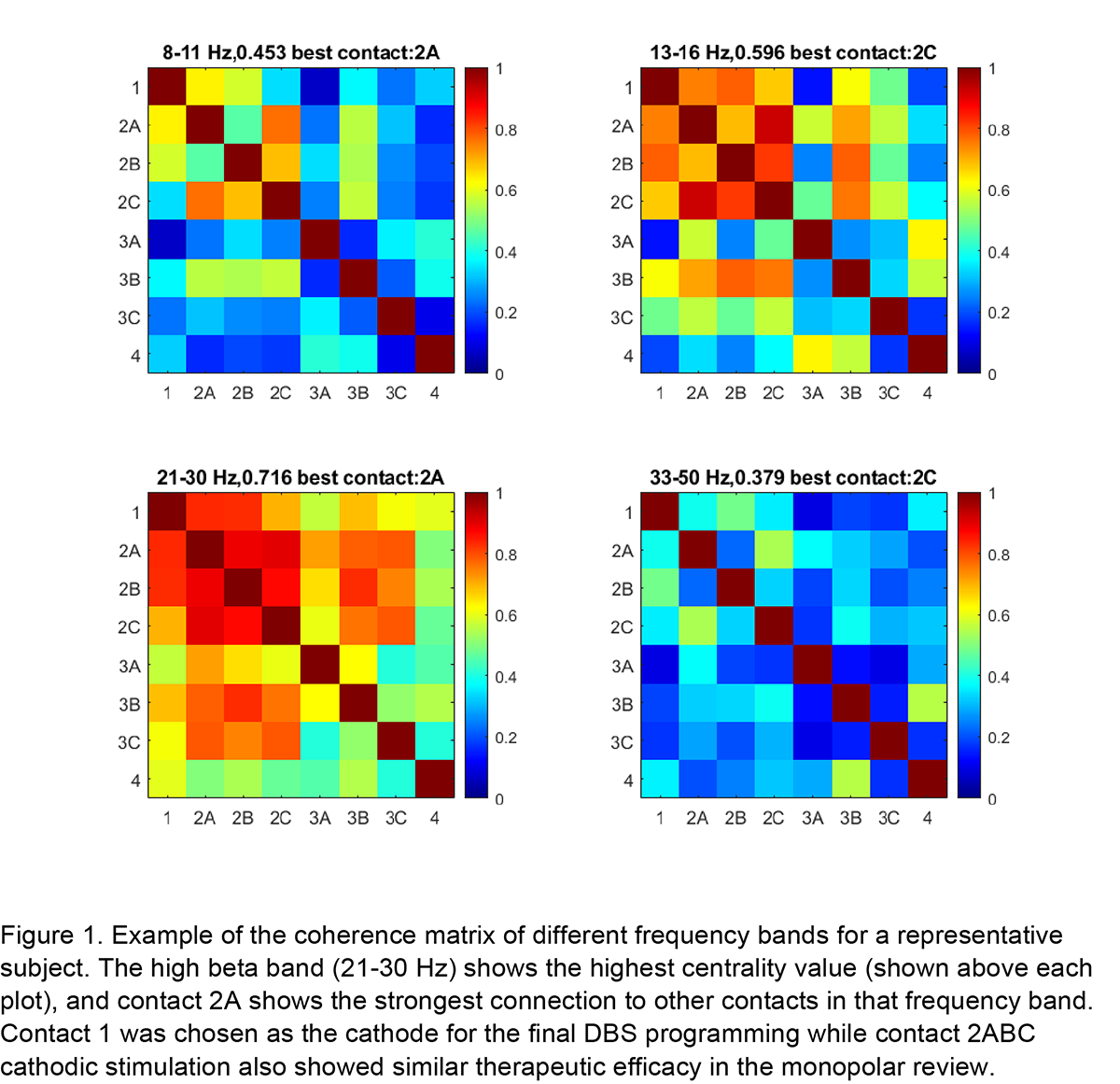Session Information
Date: Tuesday, September 24, 2019
Session Title: Neurophysiology
Session Time: 1:45pm-3:15pm
Location: Les Muses Terrace, Level 3
Objective: To determine whether local field potential (LFP) recordings from segmented deep brain stimulation (DBS) leads in the subthalamic nucleus (STN) and the globus pallidus internus (GPi) of Parkinson’s disease (PD) patients predict the active contact chosen for initial stimulation.
Background: The beta frequency band (13-30 Hz) power of LFP recordings from segmented DBS leads has been shown to be strongly correlated with the clinical efficacy of the stimulation contact selection [1]. In addition to beta oscillation, PD is also characterized by hyper-synchronization in the cortico-basal ganglia network. Therefore, we provide a local network-based analysis of LFP recordings with directional leads to select the optimal stimulation contact for DBS programming.
Method: Nine PD patients were implanted with Abbott directional DBS leads (Model 6172) targeted at STN (n=6) or GPi (n=3). During DBS lead implantation surgeries, resting state LFPs were recorded with the Grapevine Neural Interface System (Ripple, Inc) while patients were fully awake. The power spectral density was calculated for each channel and the oscillatory spectral bands were estimated using the Gaussian mixture model [2]. The spectral coherence was then calculated between each contact pair and the degree of synchronization was measured using eigenvector centrality of the coherence matrix [3,4]. The corresponding eigenvector is hypothesized to reflect how effective the stimulation at each contact would be at de-synchronizing the pathological network. The results of this network-based analysis of LFPs were compared retrospectively to results from standard monopolar review during the initial programming session for each patient.
Results: In 7 out of 9 subjects (78%), the contacts with the highest or second highest beta oscillatory band coherence eigenvector centrality were selected for DBS programming (p=0.082, bootstrapping with N=10,000; see example in Figure 1). In the other 2 subjects, the monopolar review indicated that the stimulation with the contact of the highest beta band coherence eigenvector centrality resulted in the therapeutic benefits, although these contacts were not chosen in the initial programming.
Conclusion: Synchronization analysis of LFPs could serve as a directly actionable biomarker of DBS outcomes guiding optimal contact selection, thus improving the accuracy and efficiency of DBS programming.
References: 1. Tinkhauser et. al., Directional Local Field Potentials: A tool to optimize deep brain stimulation, Movement disorders, 33(1): 159-164, 2018 2. Haller et. al., Parameterizing neural power spectra, doi: http://dx.doi.org/10.1101/299859, 2018 3. Yaffe et. al., Brain state evolution during seizure and under anesthesia: a network-based analysis of stereotaxic EEG activity in drug-resistance epilepsy patients, IEEE EMBS, 5158-61, 2012 4. M. E. J. Newman, Mathematics of networks, The New Palgrav Encyclopedia of Economics, 2nd edition, L. E. Blume and S. N. Durlauf (eds.), Palgrave Macmillan, Basingstoke (2008)
To cite this abstract in AMA style:
W. Lipski, HJ. Park, A. Jorge, A. Kent, Y. Pathak, RM. Richardson. Local beta band synchronization predicts clinically-selected deep brain stimulation contact in Parkinson’s disease patients [abstract]. Mov Disord. 2019; 34 (suppl 2). https://www.mdsabstracts.org/abstract/local-beta-band-synchronization-predicts-clinically-selected-deep-brain-stimulation-contact-in-parkinsons-disease-patients/. Accessed April 2, 2025.« Back to 2019 International Congress
MDS Abstracts - https://www.mdsabstracts.org/abstract/local-beta-band-synchronization-predicts-clinically-selected-deep-brain-stimulation-contact-in-parkinsons-disease-patients/

